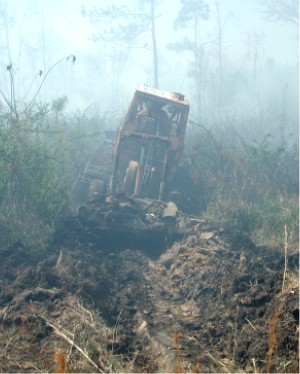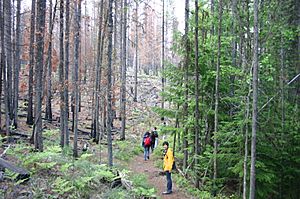Firebreak facts for kids
A firebreak is a clear area of land that helps stop fires from spreading. Imagine a wide path where there are no trees, bushes, or anything else that can burn. This empty space makes it very hard for a fire to jump across. Firebreaks are a key tool used to fight and control wildfires. They slow down or even stop a fire's movement, protecting homes, forests, and wildlife.
Contents
What is a Firebreak?
A firebreak is basically a gap in fuel. Fuel is anything that can burn, like dry grass, leaves, or trees. By removing this fuel, firefighters create a barrier. This barrier prevents flames from moving from one area to another. It's like building a wall that fire cannot climb over.
How Do Firebreaks Work?
Fires need fuel, oxygen, and heat to burn. A firebreak removes the fuel. When a fire reaches a firebreak, it runs out of things to burn. This causes the fire to slow down, weaken, or even die out. Firefighters can then work more safely to put the fire out.
Types of Firebreaks
Firebreaks can be natural or man-made.
Natural Firebreaks
Natural firebreaks are features of the landscape that already stop fires.
- Rivers and Lakes: Large bodies of water are excellent natural firebreaks. Fire cannot cross them.
- Rocky Areas: Places with lots of bare rock and no plants also act as natural barriers.
- Canyons and Valleys: Sometimes, deep canyons can slow or stop a fire.
Man-Made Firebreaks
People create man-made firebreaks to protect specific areas.
- Cleared Strips: These are wide strips of land where all plants are removed. They are often made with bulldozers or plows.
- Roads and Trails: Many roads and hiking trails are kept clear of plants. They can double as firebreaks.
- Controlled Burns: Sometimes, firefighters intentionally burn small areas. This removes fuel in a controlled way. It creates a "burned-out" firebreak.
- Green Strips: These are areas planted with fire-resistant plants. These plants do not burn easily. They can slow a fire down.
Why Are Firebreaks Important?
Firebreaks are very important for several reasons.
- Protecting Homes: They create safe zones around towns and houses. This helps keep people and buildings safe from wildfires.
- Saving Forests: Firebreaks protect valuable forests and natural habitats. They stop fires from destroying large areas.
- Helping Firefighters: They give firefighters a safe place to work. They also help firefighters control where a fire goes.
- Preventing Damage: By stopping fires, firebreaks reduce the damage to land and property.
Firebreaks are a key part of managing wildfires. They help protect our environment and communities from the dangers of fire.
Images for kids
-
Red fire retardant sprayed from the air during the Tumbleweed Fire in California in 2021. The firebreak protected the area on the right.
See also
 In Spanish: Cortafuegos (forestal) para niños
In Spanish: Cortafuegos (forestal) para niños







